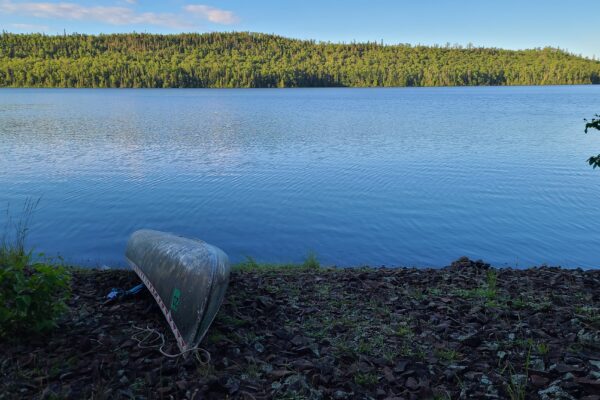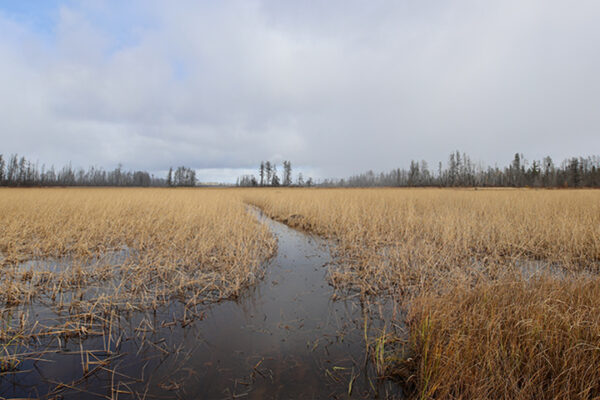History underfoot: what to do with found artifacts
North Shore residents may not be surprised to hear that this area of Minnesota has seen countless artifact finds, and that there are more all around us. Cook County resident Brian Gallagher recently came across what he believes to be an artifact in an unexpected way.
Gallagher told WTIP he noticed a flat tire while driving his work truck on some back roads. Gallagher’s son pried a projectile point out of the steel-reinforced tire as they prepared to patch it.
“You could search for hundreds and hundreds of hours and not find anything,” said Gallagher. “It’s a heck of a way to find an arrowhead.”

The projectile point Gallagher and his son pulled out of his truck tire. Photo by Brian Gallagher
The projectile point has not yet been formally evaluated, though Gallagher said he intends to have it looked at. He also added that he did not intend to keep the point long-term. He said, “It’s not mine to keep. It’s mine to enjoy for a little bit, because it’s my find, but in the long run, it’s not mine.”
Gallagher’s comments raise the question of what people should do if they happen upon something they think could have some historical or cultural value. Bill Clayton is the archeologist at the Grand Portage National Monument. He told WTIP that when an object is found on public land, the best policy is to leave it where it was, and report it to authorities.
Clayton added that photos and a GPS point are valuable information, and that in high traffic areas, hiding the object could actually be helpful in preserving the area for future examination by archeologists.
He noted that while some artifacts are easy to spot, others are hard to recognize as historical objects. There are many examples in the Grand Portage National Monument collection of tools that were only minimally shaped, and could be overlooked by the untrained eye. Clayton explained that he and other archeologists look at not only the shape of an object, but also evaluate it in the context of where it was found, to judge whether it is a material that could have occurred naturally in the area, or whether humans would have to have transported it there.


Because the exact location of the find can be a factor in determining whether an object is even an artifact to begin with, Clayton said it is especially important to leave an item where it is, if possible. “If you take something, an object, out of the context of the archeological site,” he said, “you are removing the spatial relationship of that object with other objects that is going to tell us all kinds of things about how people lived, what they ate, you know, the kinds of tools they used, how they organize their living spaces. There’s all kinds of information there.”
Beyond the academic reasons for preserving archeological sites and for reporting finds, Clayton added that it is important to consider the cultural value of historical areas. He mentioned specifically in northeast Minnesota that respecting the history of indigenous ancestors was “most important.” He added, “There’s sort of a sacred aspect to keeping those sites intact.”
When an item is found on private land, what happens to it is up to the property owner. However, on public lands, Clayton said artifact finds must be reported to the agency with jurisdiction. He said that while the Minnesota Department of Natural Resources and Superior National Forest may not have archeologists in all of their offices, they do employ archeologists, and visitors can still report artifact finds to the nearest ranger station or DNR office. He added that many tribes have a preservation officer, so finds can be reported at tribal council headquarters. The state of Minnesota also runs a State Historic Preservation Office, and for other local finds, he suggested contacting the city or local historical society.
While many inadvertent finds are picked up, whether by accident, like Gallagher’s find, or by someone excited to have found an artifact, Clayton said items can always be turned in later. He added that any notes about the location of the find are helpful.
Clayton said that finding an artifact can be enjoyable, but he reminded listeners, “It’s a great experience. There’s no doubt about that. But just, you know, respect these areas, these public lands that you’re recreating in, and leave it there and report it.”
WTIP’s Kirsten Wisniewski spoke with Brian Gallagher about his inadvertent artifact find, and National Parks Service Archeologist Bill Clayton about how people should handle a find on public lands. Audio from those interviews is below.














